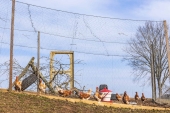


Jay Angler wrote:Yes, they have been coppicing for firewood in places for over a thousand years, so finding good locally adapted plants for that approach makes a huge amount of sense. ( Coppice Agroforestry by Mark Krawczyk : review here https://permies.com/wiki/203188/Coppice-Agroforestry-Tending-Trees-Product )
I'll also suggest that people know the ecosystem requirements of trees - some will hog water to get that excellent growth, which then denies water to native, locally adapted trees.
And please don't plant monocultures - most coppiced areas use more than one species, and only chop relatively small areas on any one year, and have been shown to improve diversity of birds and amphibians, whereas monocultures tend to reduce biodiversity.


Jeff Lindsey wrote:Ok, some more on slingshots.
Cans hung from trees and lined up on boards, IMHO, make the best targets. It is simple and cheap and traditional for a reason. The feedback from the ammo hitting the can is instructive and fun. You will probably be shooting at things on the ground, below your normal line of sight, and things higher than your normal line of sight, so practice those shots. Shooting down is always tricky. When you get good, have someone toss the cans up for you. You can get good enough to hit those.
After a while, don't buy ammo packaged as such, except the clay stuff for use when you can't recover your ammo. It is too easy. Scrounge it. Go to good riverbeds and beaches to find smooth round rocks, find marbles and ball bearings in thrift stores, cast your own .50 caliber lead balls for the serious shots. If you value your ammo like a poor kid values their ammo, you will shoot with more care and you will have more fun as the ammo sourcing becomes part of the process. Paint balls can be shot, with all sorts of effects, but you can't squeeze the pouch hard.
Keep the clay, marbles, and ball bearings to the inanimate objects. If you are ending varmints larger than mice, the animals deserves the clean kill of a heavy lead ball or a heavy steel hex nut shot vertically at short range, not a broken bone or a slow death from internal injuries because you have some fear of lead. Wear a thin glove if you must. Don't shoot birds at all unless you mean to kill them, a marble or even a bb can maim their fragile bodies. I have seen with my own eyes a turkey's breast plate stop bird shot. I have also seen turkey's tragically blinded by bb shot and turkeys trying to survive with a broken wing. Either kill the bird or use a method to scare it away. Don't wound animals.
Inspect your bands before every practice session, paying special attention to the ends of the tubes on wrist rockets. Cracked tubes at those points, on the sling or pouch, are the main points of failure.
Wear eye protection. It only takes one little failure of a bit of rubber to ruin your eye. It is really the only danger, except shooting your own hand that is supporting the slingshot. Just wear a pair of safety glasses.
There's a lot of options for carrying ammo. A small Crown Royal bag was the cool thing in 1985, and anything cool then is magically cool in these lesser times. I personally believe that a green Crown Royale bag gives you a +1 to hit, but your mileage may vary. Cigar tubes are the best paintball carriers if you are packing these discreetly.
For the real sling, paracord works as well, if not better, than natural fiber rope. Leather remains the best choice for pouches. River rocks and old billiard balls are your easily sourced ammo for these slings. You can fit 4 billiard balls in a 1980's era army surplus M16 magazine pouch and still close the pouch securely, in case you were wondering.
Happy slinging again.


